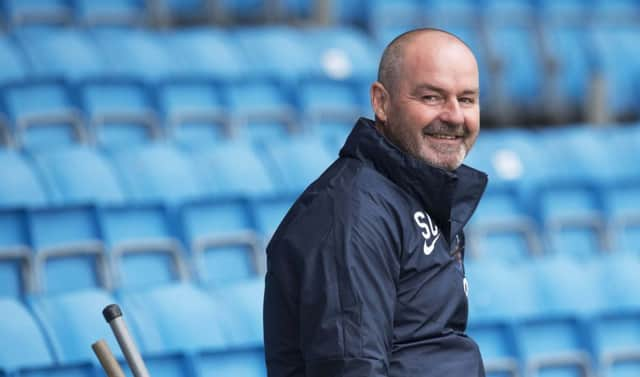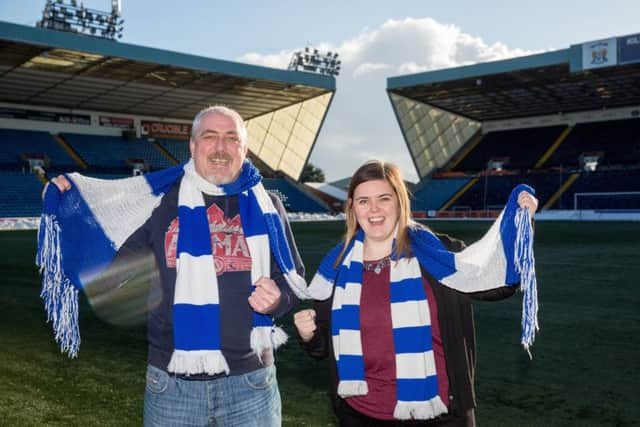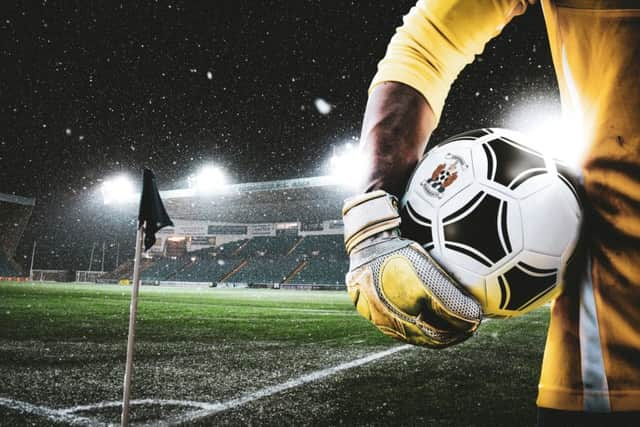Insight: Can Kilmarnock’s football success revitalise the town?


Rebecca Millar was just 14 hours old when she was registered as a member of the KGB (Kilmarnock Girls and Boys supporters’ club). Her dad Stephen – known as Foggy on account of his booming voice – had come, elated, from the hospital to the Rugby Park Open Day to buy a blue and white teddy, and signed her up on a whim. At the time, she was the youngest ever official fan. A year later, another baby snatched her title, having been registered at eight hours old. But, hey: that’s football. Ups and downs.
Rebecca, now 25 and a career development officer, has followed the ups and downs of Kilmarnock FC all her life. Having been carried in to home games in her car seat – and cooed over by players’ wives and members of staff – her entire identity, and the identity of her sisters, Rachel and Jenny, is inextricably bound up with the club.
Advertisement
Hide AdAdvertisement
Hide AdThe best day of her life was when Kilmarnock won the League Cup in 2012 with a 1-0 victory over Celtic at Hampden in 2012. “We thought it was going to extra time, then big Dieter Van Tornhout scored that goal and I can’t even explain the feeling. It was pure euphoria,” she says.


One of the worst came when Kilmarnock lost 5-1 to Hibs in the League Cup final in 2007. “I was there with my big Killie flag and my face painted and I was sobbing my wee heart out.”
Stephen swears the first time his daughter smiled was when he told her the team had beaten Rangers at Ibrox in August, 1993. “Aye, but supporting Killie has brought more disappointments than victories,” she replies.
Right now, as Kilmarnock, the oldest professional team in Scotland, celebrates their 150th anniversary, their supporters have plenty to keep them cheerful. With a tiny fraction of the Old Firm budget, current manager Steve Clarke has transformed the team, taking them from bottom to fourth in the Scottish Premier League.
Since replacing Lee McCulloch in 2017, the Saltcoats boy-made-good has produced victory after victory, including the one against Rangers 11 days ago, which was the source of much joy.


In December, Kilmarnock were briefly top of the SPL and, after defeating Rangers, second. Nor has the team’s success been a flash in the pan: Kilmarnock collected more points over the course of 2018 than any other team in the premiership.
“Steve has given the players back their self-belief,” says Sandy Armour, editor of the club fanzine, the Killie Hippo. “At one time, if Kilmarnock were playing Rangers and Rangers scored, the heads would go down and it would be over. But Steve has instilled a winning mentality.”
If a league win still seems far-fetched, a top three finish and a jaunt to Europe does not. And miracles can happen. There must be Killie fans who are looking to Leicester’s league win; and daring to dream.
Advertisement
Hide AdAdvertisement
Hide AdWhatever transpires, Clarke’s success is breathing fresh life into the flagging club. Gates – down to 3,500 in 2016 – have risen, doubling to 7,000 for big games. The Moffat stand, closed last season due to a lack of ticket sales, has reopened, and a fan zone has been created in its shadow. More young families are starting to appear, with children once again running down to the front to see Nutz the squirrel, the club mascot.
“Before Clarke came, it felt like we were losing a generation of fans,” says Armour. “But now we are seeing younger supporters and they make more noise than the auld yins sitting with our blankets. They create more atmosphere.”
Better still – as the fates of provincial towns and their football clubs tend to be intertwined – the unexpected upturn in Kilmarnock’s fortunes is filtering out beyond Rugby Park.
The club shop, the Killie Zone, has expanded, opening a new unit in the town centre, and residents who might naturally have gravitated towards Glasgow at the weekends are more likely to stay home.
“It’s amazing. You see people on a Saturday afternoon now, and they are just uplifted – it’s changing the mood of the whole town,” says Tracy Murray, chair of Kilmarnock Business Association, who owns the Cove Boutique on Bank Street, a thriving shopping thoroughfare.
The Hard Luck Tattoo shop in Titchfield Street is getting so much trade it may have to consider a name change. Niky Brown has had a succession of Kilmarnock players through his doors asking to be inked. Brown is the man responsible for putting the sleeves on Eamonn Brophy. He demonstrates the player’s celebration gesture – the middle fingers of both hands bent inwards as both hands form a W – as he describes the Wolf on the inside of the striker’s right arm. His next job is to ink a bigger wolf across his back.
“The fact these players come here instead of going to Glasgow is good for the town,” says Brown. “The last time Brophy was in, he was signing autographs.”
Brown, who is a walking advert for his own work, has also been inking Killie badges on the calves and shoulders of fans finally ready to swear a blood oath to the club. He himself plans to get a squirrel on his upper arm. So what about the manager now revered as a demigod? Has Brown been asked to tattoo Steve Clarke’s face or name on any body parts? “Not yet,” he laughs. “But I tell you what: if anyone wants to be the first, I’ll do it for free.”
Advertisement
Hide AdAdvertisement
Hide AdA decade ago, Kilmarnock was in the doldrums. It had already lost much of its heavy industry. So Diageo’s decision to close the Johnnie Walker bottling plant, which employed 700 people, was a massive blow. The residents reacted with defiance, organising a 20,000-strong march along John Finnie Street to Kay Park. But three years later the plant shut anyway, leaving few families untouched.
Johnnie Walker was also a core part of the town’s identity. “If you went abroad people would ask where you were from and maybe people wouldn’t have heard of Kilmarnock, but then you’d say ‘Johnnie Walker’ and there would be a spark of recognition,” says Murray.
In between the Diageo announcement in 2009 and the closure in 2012 came The Scheme, a BBC reality TV show set on the Onthank estate which focused on a handful of mainly dysfunctional individuals.
Talk about kicking a place when it’s down. The programme stigmatised an entire community to the extent that even now, when Outlander actor Steven Cree tells people in London he is from Kilmarnock, they ask if he’s from Onthank (he is, and proud of it). “That was the most irresponsible thing the BBC could have done,” says Murray.
But people from Kilmarnock are not easily broken. Coco Chanel’s aphorism “Keep your heels, head and standards high” hangs at the front of Murray’s shop; perhaps it ought to be incorporated into the town’s crest.
After the shock of the Johnnie Walker closure had been absorbed, key members of the business community came together to try to harness some of the latent creativity and innovation and to push for investment.
Already, various improvement schemes were under way: the Opera House underwent a £7.5 million regeneration; and the Johnnie Walker Bond was upgraded and turned into the council’s social work department. A Conservation Area Regeneration Scheme was created around John Finnie Street; car parks were refurbished.
The ghost of the Johnnie Walker bottling plant was partly exorcised when Ayrshire College – a £50m glass temple of learning, which sends shafts of light across the town – was erected on eight acres of the site. The building was the work of Keppie Design, whose design director David Ross grew up in Onthank and still lives in the town.
Advertisement
Hide AdAdvertisement
Hide AdMeanwhile Kilmarnock-born entrepreneur Marie Macklin is the driving force behind HALO, an innovation and enterprise hub, which is set to be built on the other 20 acres. When Kilmarnock won the SURF regeneration award for Scotland’s most improved large town in 2015, it was a testament to its indomitable spirit.
As the town was hitting hard times, so too was its football club. Part of this was down to unemployment. “The fortunes of a football club ebb and flow along with the economy. When people are out of work they can’t afford to go,” says Armour.
When they’re winning, of course, football clubs can lift morale. You could see that in Newcastle during the Alan Shearer era, when the Toon and its success was the one positive in many people’s lives. You could see it, too, when Kilmarnock won the Scottish Cup in 1997. “There is nothing else in the town or the shire that could have induced that kind of reaction,” says Armour. “You didn’t have to be a football fan. As the bus carrying the players and the cup came into Kilmarnock, there were wee grannies hanging oot their windows.”
A few years later, however, under the chairmanship of Michael Johnston, a disconnect began to develop between the fans and the board. Johnston, who had been gifted his shares by the previous owner, was widely regarded as being more interested in lining his pockets than in the club.
Gradually fans stopped buying season tickets, protest banners were unfurled at matches and the supporters’ association launched the Not A Penny More campaign in an attempt to oust him.
The protest proved successful and, in 2014, Johnston stood down as chairman in a deal that saw the sale of the Park Hotel and the club’s debts cleared. In 2017, Johnston resigned from the board. Next month, he is expected to sell his last shares and cut all remaining ties. Before standing down as chairman, Johnston set up Kilmarnock Community Sports Trust, a registered charity, to run the club’s community department in a more financially efficient manner.
By then, both results and support had stagnated. But the Kilmarnock Supporters’ Society (widely known as the Killie Trust) worked closely with majority shareholder Billy Bowie and the other directors to restore confidence.
Last year, the trust raised the £100,000 required to allow trust director and former Kilmarnock and Loudoun MP Cathy Jamieson to join the club’s board, thus increasing the fans’ input.
Advertisement
Hide AdAdvertisement
Hide AdAs tends to happen with folk heroes, the story of Clarke’s appointment has entered the realms of myth. It was such a stroke of genius backed up by brass neck, there are multiple contenders for the credit.
The version I have chosen to believe places the impetus for the initial approach in the hands of the fans, and particularly the chairman of the Killie Trust, Jim Thomson.
It was Thomson, Armour says, who first put Clarke’s name to the directors; and Thomson who gave them a number for Clarke’s brother Paul, an ex- Kilmarnock player. Paul took the call on a golf course in Tenerife, and promised to contact Steve.
Kilmarnock are a club well accustomed to surreal twists of fate. It is weird enough that their anthem is Paper Roses; weirder still that a punk rock version of the song is sometimes played at matches. But who could have imagined that Marie Osmond – on hearing of the connection – should take it upon herself to visit Rugby Park and adopt Kilmarnock as her favourite team?
Yet Killie supporters appear more shell-shocked that Clarke – who had coached alongside Ruud Gullit at Newcastle, José Mourinho at Chelsea and Kenny Dalglish at Liverpool – was prepared to sign on the dotted line. Nor can they get their heads round the transformation he has wrought. On Twitter, they call him SSC – Sir Steve Clarke – and a tongue-in-cheek Facebook page, The Church of Saint Steve Clarke, has been set up to pay homage to his greatness.
Even Armour, who has seen good managers come and go, is awed by Clarke’s achievement. “Steve has done all this without bringing in a large number of new players. He is the outstanding manager in Scotland by a mile in my opinion. If he had the budget of Celtic or Rangers then just imagine…” he says.
Kilmarnock FC’s profile is also being boosted by celebrity fans who are vocal in their social media support. Two members of Biffy Clyro – twins Ben and James Johnston – are sometimes spotted at the games. And then there’s Cree, who recently tweeted Gary Lineker to ask if him if he’d repeat his Leicester stunt and present Match Of The Day in his boxer shorts if Killie won the SPL (Lineker promised he’d present it wearing Killie socks instead).
Cree’s history with the club is literally etched into his face. He was 17 when Kilmarnock won the Scottish Cup, and well up for the post-match celebrations. As the town went wild, he climbed up on to, and then jumped from, a moving van, splitting his forehead and finger. “I spent the night in A&E,” he says “I needed 17 stitches and still have the scar above my left eyebrow.”
Advertisement
Hide AdAdvertisement
Hide AdCree is based in London and has a one-year-old daughter; but he is coming to as many games as he can. “I find most people who aren’t Old Firm fans are proud not to be because there is something special about supporting your home town team,” he says. “While I am sure it’s great winning the league every other year, the fact this season is unexpected for us means it is bringing us so much joy.
“We don’t know how long this is going to last so it’s important to savour every moment.”
Here is the unspoken fear that casts a shadow over fans’ happiness: how long will SSC stay? Armour doesn’t believe he’s a man to be lured away by big bucks. And yet, if he keeps on producing these results, other clubs will be competing for his services.
On the assumption that it won’t be like this all the time, the club and the Killie Trust are doing everything they can to consolidate their links with the community while the going is good.
Earlier this year, they introduced a Community Hero Award with a local champion recognised before every game. And local businesses are being encouraged to donate a season ticket to families that might otherwise be unable to attend.
In his office at East Ayrshire Council HQ, the world’s most unlikely provost is also buoyed up by Kilmarnock’s rise. Jim Todd, who sometimes turns up at functions on his Harley-Davidson, is wearing a leather waistcoat with chains instead of buttons. On the right-hand side is an Ace of Spades; on the left a sewn-on badge reading “Provost”.
Though he is not a great football fan, his office is full of club paraphernalia. Three rival scarves – Kilmarnock, Auchinleck Talbot and Ayr United – share the same coatstand. The wall behind him boasts a Killie calendar and photos of Marie Osmond’s visit are also on display.
“The town has got its sense of pride back and the club has a lot to do with that,” he says. “If there’s football on the telly – Barcelona, Real Madrid, Manchester United, I am not interested – I’d rather be out on my bike. But I love Kilmarnock and am a season ticket holder.”
Advertisement
Hide AdAdvertisement
Hide AdTodd says the strengthening links between the club, the community and the council can be seen in plans to build a memorial garden next to the stadium. “Like Hearts, Kilmarnock players went away to World War One and never came back,” Todd says. “And it will double up as well. When Kilmarnock supporters pass over, they want their ashes on the park; but you can’t scatter ashes on a plastic pitch.”
It’s 6.45pm on Friday night and hundreds of Kilmarnock fans, their scarves wrapped tight around their chins, are trudging through the falling snow to watch their team take on Hearts.
There are groups of old men, teenagers swilling cans of Tennent’s and hyper children bouncing around their mums and dads.
One boy in a bobble hat gives an impromptu dance as he chants: “Now we have a leader, his name is Stephen Clarke.” I’ve spent so much time with fans in the past seven days, I mentally reply: “You’ll never take the Killie, the boys from Rugby Park.”
Two recent developments are being hotly discussed. The decision to replace the existing artificial pitch, not with grass, but with another artificial pitch, is a disappointment quickly eclipsed by the news that fans’ favourite, Youssouf Mulumbu, is coming back on loan from Celtic.
Some supporters, like Innes Thomson, have travelled a long distance. Thomson lives in Dunoon but comes to every home match and most away ones. Just six days ago he saw Kilmarnock draw 1-1 against Aberdeen at Pittodrie.
Other supporters, like Ally Fotheringham, are relatively new to the Kilmarnock family, drawn in by the excitement and the tickets their children have scored through their boys’ clubs.
In the end Kilmarnock lose 2-1. But there’s always the Scottish Cup match against Rangers to look forward to on Saturday. Another victory against their Old Firm rivals would be sweet.
Advertisement
Hide AdAdvertisement
Hide AdIn any case, right now, it would take more than a one-off loss to dash the fans’ optimism.
“It’s been amazing,” says Thomson. “After everything we’ve had to put up with, to suddenly be in this position is just incredible.”
So are Kilmarnock about to do a Leicester? “I don’t want to jinx it, but I think we have a chance,” he says. “I’m more than happy with [Clarke’s] signings.
“I think Celtic will still be the favourite. But even if we came second, it would be almost as good as a win for our generation.”